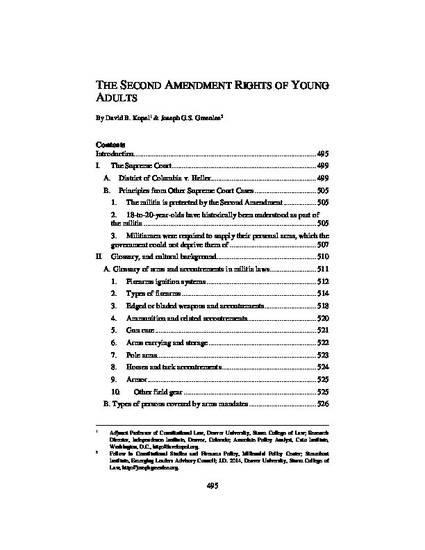
Article
Second Amendment Rights of Young Adults
Southern Illinois University Law Journal
(2019)
Abstract
Since the Supreme Court’s 2008 decision in District of Columbia v. Heller, lower courts have analyzed diverse Second Amendment issues. One question is whether young adults—that is, persons aged 18-to-20—have Second Amendment rights. This article suggests that they do. Indeed, under Heller’s originalist methodology, this is an easy question.
Part I examines what the Supreme Court has said, explicitly and implicitly, about the Second Amendment rights of young adults.
Parts II and III survey colonial and founding-era sources. Part II begins with a glossary of various terms that were used in militia statutes. These show some of the arms and accoutrements that Americans were required to possess. The various items illustrate that the right to arms does not include only firearms and ammunition. The right also includes, for example, edged weapons and gun-cleaning equipment. Part II also describes the arms culture of early America, where it was a point of national pride that people were trained to arms “from their infancy.”
Part III then surveys all the militia statutes from the earliest colonial days through 1800. The survey pays particular attention to two issues. The first is the age for militia service or for other forms of mandatory arms possession. As the statutes demonstrate, arms possession was mandatory for militiamen and for other categories of people. In some colonies, for example, every head of a house, regardless of gender, had to possess arms. So did men who were too old for militia service. The most common ages for mandatory militia service were from 16 to 60. But by the end of the eighteenth century, the militia mandate had been narrowed in most states to 18 until 45 or 50.
The second issue in Part III is the types of arms that militiamen—and the many other people required to possess arms—were supposed to own. Part III tracks the evolution of these laws, as they become more specific about requiring various accoutrements—such as gun cleaning equipment, holsters, and ammunition storage devices—and the laws’ attempts to ensure that the public possesses modern arms.
Part IV describes federal laws regarding the ages for arms possession. These include the 1792 statute making 18-year-olds into members of the federal militia (as they are today, by statute), the 1968 Gun Control Act setting age limits on purchases in gun stores, and the 1994 federal law restricting handgun possession by persons under 18.
Part V covers the five leading post-Heller federal circuit court cases on age limits for exercising Second Amendment rights. Two of these cases relied heavily on cases and statutes from the nineteenth century; thus, in the course of discussing the cases, we survey the nineteenth century developments. By the end of the century, a substantial minority of states that placed some restrictions on handgun acquisition by persons under 21.
Finally, Part VI describes some of the present-day state laws that limit firearms acquisition or possession by young adults (18 to 20). Part VI also considers various past and present age limits in American law for different activities, such as voting, vices (e.g., alcohol, gambling), marriage, and the right to keep and bear arms.
In conclusion, this article finds that there is some historical precedent for extra regulation for handgun acquisition by young adults, and very little for extra restrictions on long gun acquisition. Pursuant to Heller, extra regulations for young adults may be permissible, but prohibitions or quasi-prohibitions are not. The Second Amendment rights of young adults include a core right affirmed in Heller: acquiring and keeping a handgun in the home for lawful self-defense.
Keywords
- Second Amendment,
- young adults,
- gun control,
- militia,
- firearms
Disciplines
Publication Date
2019
Citation Information
David B Kopel. "Second Amendment Rights of Young Adults" Southern Illinois University Law Journal Vol. 43 Iss. 3 (2019) p. 495 - 613 Available at: http://works.bepress.com/david_kopel/63/
